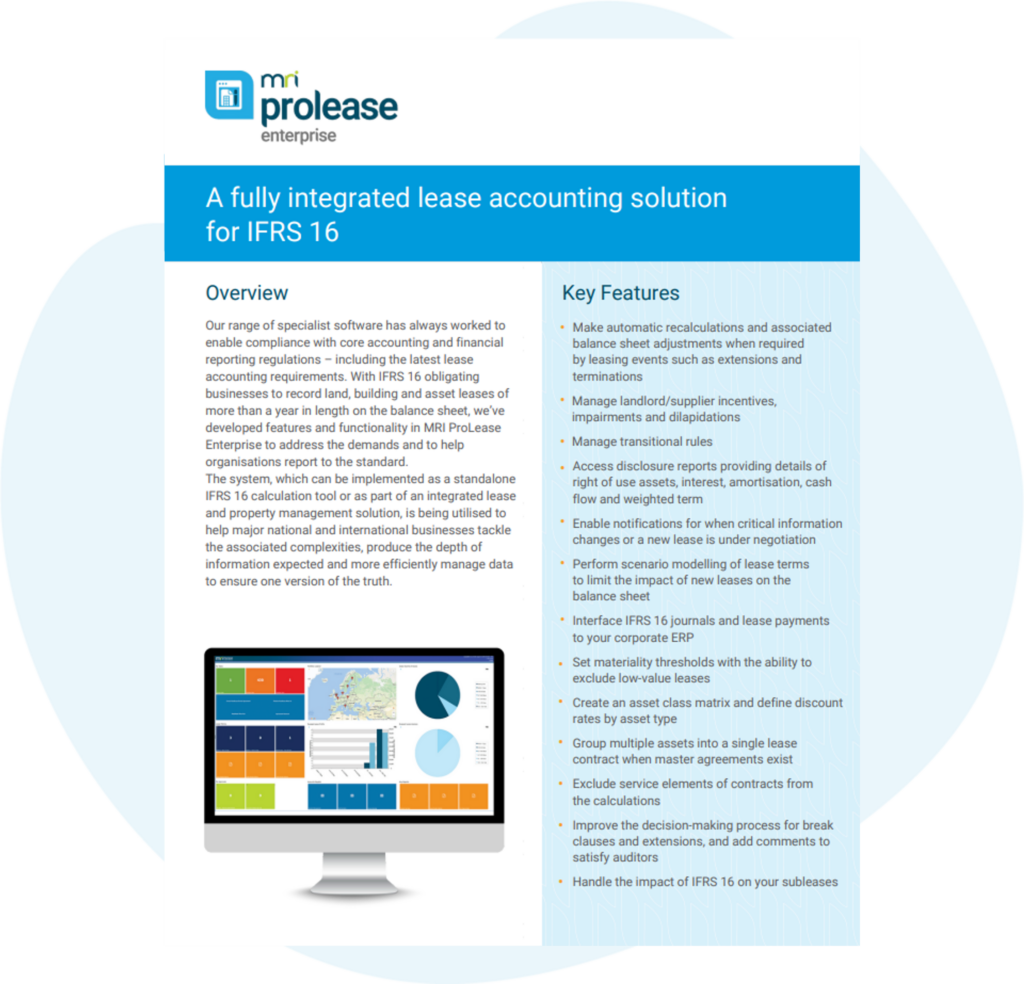Preparing for FY20: How to ensure AASB 16/IFRS 16 compliance this EOFY and beyond
Accounting standard AASB 16/IFRS 16 is effective for reporting periods commencing on or after 1 January 2019, meaning that for many companies in Australia reporting begins from July this year.
Already it has become widely accepted to be one of the most complex standards ever to be introduced – causing headaches for many lease holders.
If you haven’t noticed it affecting your role or organisation just yet, don’t be surprised if it soon does. The new Financial Year is fast approaching for Australia, and for those not well prepared, it’ll be a real rush to maintain compliance with International Accounting Standards.
From now, financial reporting will require compliance with AASB 16/IFRS 16 – which is no easy feat.
If you haven’t already, now is the time to properly prepare your business for AASB 16/IFRS 16.
AASB 16/IFRS 16 will have a dramatic effect on ‘The Numbers’
By effectively replacing operating leases with finance leases, AASB 16/IFRS 16 creates a fundamental change to the methods of reporting for a business.
Where once lease payments were simply recorded as an operating expense as part of an annual Profit & Loss statement, under the new standard, all future lease payments will need to be recorded on the Balance Sheet.
As a result, not only will a company’s net asset position change, potentially impacting debt ratios and banking covenants, but such a change could also result in a significant shift in EBITDA, as a large cost is transferred ‘below the line’.
There are also situations, in countries like Australia, where a sufficient increase in a private company’s gross asset position due to AASB 16/IFRS 16 could even result in it being deemed a ‘financial reporting entity’, enforcing a greater level of complexity, compliance and cost.
For those companies effected the urgency is not just about ensuring that they can report the numbers correctly, but what will the actual impacts be for the company’s financial position, both on Balance Sheet and in the Profit & Loss.
AASB 16/IFRS 16 Compliance requires more data than you think
Having worked with dozens of organisations that have already begun adopting AASB 16/IFRS 16, the single biggest mistake that my team regularly sees is companies under-estimating the level of NEW data required to even calculate the required entries.
Unlike finance leases for equipment and vehicles, real estate leases typically have far more complex structures such as regular and variable adjustments to payment amounts (rent reviews), options, extensions, renewals and even sub-leases.
Given real estate matters are traditionally managed outside of the finance department it is understandable that many internally are underestimating the quality and availability of the data required for these leases under AASB 16/IFRS 16.
Add to this, the chronic underinvestment that most companies make into lease management systems and the ability to maintain AASB 16/IFRS 16 compliance becomes heavily compromised.
In our work to date with numerous retailers and corporates across the EMEA Region, we’ve seen firsthand the chaos AASB 16/IFRS 16 causes groups with insufficient data and poor systems.
Common problems revolve around misconceptions that detailed data for real estate leases can easily be obtained and verified, based on false expectations that:
- Data can be collected and collated within a matter of days or weeks;
- The necessary data is already in the hands of Property Managers and real estate teams, ready and waiting;
- Existing data sets will be sufficient; and
- Available data is sufficiently accurate and usable.
For most businesses the current scope of data that they are maintaining for real estate leases is narrower than what they’ll require for AASB 16/IFRS 16.
Commonly housed within a series of spreadsheets, this data will typically have data integrity issues and lack the necessary controls required for audit and compliance purposes.
All of these issues become even more significant to solve when the company and its directors have to be able to stand behind the numbers being reported – for any Director, the reporting of flawed financial statements is just NOT an option.
My advice? Don’t delay – get started today
For those companies reporting under AASB 16/IFRS 16, the risks of non-compliance are very real, and it’s not too late to be prepared. Despite the complexities of the new standard there is a clear pathway to being able to adopt them for your organisation.
At MRI ProLease Express, my team and I have spent a lot of time over the last eighteen months working side-by-side with organisations as they prepare for AASB 16/IFRS 16. From our point of view the essential steps to take are as follows:
Connect the property and finance teams
Adopting AASB 16/IFRS 16 is not just a ‘finance issue’. The importance of a good property administration team has never been greater. It is essential that property and finance be aligned and in constant communication, both ensuring that the business’ lease information is complete, accurate, highly available and being managed in a way that will ensure its ongoing integrity as well as satisfying any necessary audit controls.
Identify the additional data points required for leases
What does your existing real estate lease data comprise of? What additional data points do you have to capture and manage? Commencing rents, annual rent reviews, fitout incentives, option periods and make goods are all potentially required.
Verify your lease data
Compliance with this new standard cannot be achieved without correct real estate lease data – it is the centrepiece of AASB 16/IFRS 16. To ensure the accuracy of financial statements, the adoption of AASB 16/IFRS 16 is an ideal opportunity to verify this data against your source documents.
Develop a formal policy for their adoption
In addition to the required source data there are numerous business decisions required to adopt and comply with AASB 16/IFRS 16. In consultation with financial advisors, the organisation is required to make a range of determinations upfront and on an ongoing basis, including which transition method to use, the applicable interest rate(s) to be applied for DCF calculations, as well as the inclusion of future lease options.
Update your systems
Due to the complexity of the calculations that form the basis of financial reporting under AASB 16/IFRS 16, the greater scope of decision making required, and the need for enhanced control and auditability, leaving the management of real estate lease data with Excel will no longer suffice.
If your organisation leases real estate then adding lease management to your framework of financial systems will be essential.
Reviewing a system already designed for AASB 16/IFRS 16 compliance is a great place to start.
The long-term pay off
Although right now many organisations are focused on the changes for AASB 16/IFRS 16, this will not be a once-off requirement. Rather it will be an additional method that needs to be managed ongoing and integrated into existing financial reporting processes as easily and as seamlessly as possible.
Whilst the current challenges of transitioning to the new standard are significant, for those organisations that do not implement a best practice approach, the difficulties over the longer term will be even greater.
For those without the appropriate systems, even the basic need of accurately tracking all of the movements within their real estate lease profile between each reporting period will present a challenge, let alone the additional business risk.
Unfortunately, there’s no way around it – for many, AASB 16/IFRS 16 compliance is essential. So with data verified, appropriate policies, and the right systems in place, this new standard can also be managed alongside all other AASB 16/IFRS 16 requirements, ensuring your organisation can achieve:
- Continued AASB 16/IFRS 16 compliance
- A greater ability to respond to information and analysis requests from management and/or the board
- Faster and more accurate preparation of financial statements
- Improved audit and controls
At MRI ProLease Express, our team has helped hundreds of lease holders ‘get on top’ of their lease data.
We currently work with organisations around the world dealing with the adoption of AASB 16/IFRS 16. Our software is now proven to be AASB 16/IFRS 16 compliant, ensuring that once you have on-boarded with MRI ProLease Express, you can immediately produce the financial reporting entries you will require for now and into the future for AASB 16/IFRS 16.
MRI ProLease Express can also help you collate, verify and migrate your data for your new system – providing real-world knowledge and experience along the way. If you are seeking assistance in preparing for AASB 16/IFRS 16, click here to get in touch with MRI ProLease Express directly.
Workplace
Software solutions and services for workplace management, lease administration and lease accounting.
Get a Demo
A fully integrated lease accounting solution
for IFRS 16
In today’s dynamic financial landscape, achieving compliance with evolving accounting and reporting regulations is more critical than ever. MRI stands at the forefront of facilitating this compliance, particularly in light of the demands set fo…
